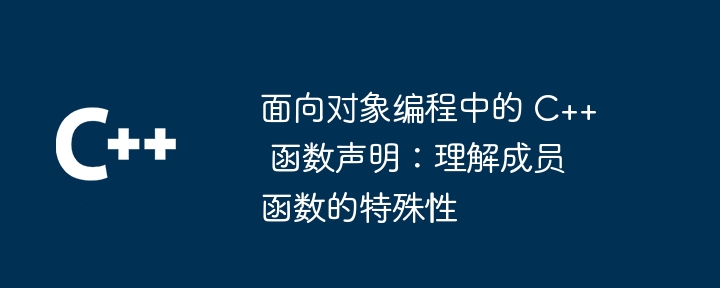Home >Backend Development >C++ >C++ Function Declaration in Object-Oriented Programming: Understanding the Specialities of Member Functions
C++ Function Declaration in Object-Oriented Programming: Understanding the Specialities of Member Functions
- PHPzOriginal
- 2024-05-04 17:45:01804browse
Special declaration conventions for member functions in C include: explicitly specifying the class name to indicate which class the function belongs to. The implicit this pointer points to the object calling the function, allowing access to object data members and methods.

C Function Declaration in Object-Oriented Programming: Understanding the Special Characteristics of Member Functions
Object-oriented programming (OOP) is a A software development paradigm that encapsulates data and methods (functions) in objects to promote code reusability and maintainability. In C, object methods are called member functions, and they have a unique declaration convention that differs from ordinary functions.
Member function declaration syntax
The declaration syntax of member function is as follows:
returnType className::functionName(parameterList);
- returnType: Function return value type.
- className: The name of the class it belongs to.
- functionName: Function name.
- parameterList: Function parameter list, the data type is indicated in parentheses.
Speciality:
-
Explicitly specify the class to which it belongs: Class name (
className) Used to clarify which class the member function belongs to. This is the main difference between member functions and ordinary functions. -
Implicit this pointer: Each member function implicitly contains a
thispointer, pointing to the object that calls the function.thisPointers can be used to access data members and methods of an object instance.
Practical case:
Consider a Person class that has a age data member representing age And a getAge member function to get the age:
class Person {
public:
int age; // 数据成员
int getAge() { // 成员函数
return age;
}
};Member function call:
Member function can be called through the object instance of the class, as follows Shown:
Person John; // 创建 Person 对象 John.age = 30; // 设置 John 的年龄 int age = John.getAge(); // 调用成员函数并存储返回值
It can be seen that member function declaration allows us to define class methods and specify their relationship with the class to which they belong. Key features of member functions are explicit ownership of the class and implicit this pointers, which allow an object instance to access its own data and methods.
The above is the detailed content of C++ Function Declaration in Object-Oriented Programming: Understanding the Specialities of Member Functions. For more information, please follow other related articles on the PHP Chinese website!

